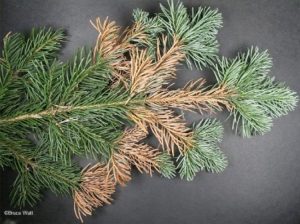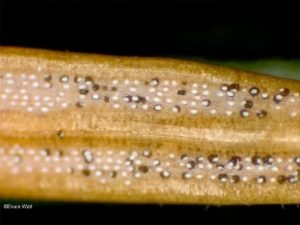Rhizosphaera Needlecast
Pest Management Fact Sheet #5104
Authors: Dr. Alicyn Smart, Dr. Bruce Watt, and Abigayl Novak
For information about UMaine Extension programs and resources, visit extension.umaine.edu.
Find more of our publications and books at extension.umaine.edu/publications/.
Other Name: Needlecast
Pathogen: Rhizosphaera kalkhofii
Introduction

Rhizosphaera Needlecast is a fungus that can cause extensive defoliation of spruce and fir, especially where the trees are grown out of their natural range. In the spring, spores are dispersed by rain splash or by the wind from infected needles to healthy susceptible growth where infection occurs. In plantations, the spores may also be spread mechanically by workers as they walk down the rows or by pruning shears and other equipment. Colorado blue spruce is especially susceptible to infection, along with other species of spruce and true firs that can sustain some damage. Christmas tree plantations can have extensive damage and can cause lower tree market values. Tree vigor is also reduced, and successive years of defoliation can lead to the death of the tree.
Host Plants
Spruce (Picea), True Fir (Abies), Douglas Fir (Pseudotsuga), Pine (Pinus), Cedar (Cedrus), and Hemlock (Tsuga)
More specifically,
- Colorado blue spruce (Picea pungens), White spruce (P. glauca), Oriental spruce (P. orientalis), Norway spruce (P. abies) and Red spruce (P. rubens)
- White fir (Abies concolor)
Symptoms and Signs

In general, the disease tends to begin in the lower portion of the tree and work its way up. Typically, symptoms appear on the older needles as a brownish purple discoloration and eventually lead to death while the younger leaves remain non-symptomatic (see Figure 1). Rhizosphaera spores require 72 hours of moisture on the needles at about 77°F to germinate and infect the needles. Such conditions occur during extended rainy weather and also under poor drying conditions. Shaded trees, trees with dense foliage, and trees in areas of poor air circulation are the most susceptible. Due to this, tender new needles and older needles of trees stressed by various environmental and cultural factors are vulnerable to the disease.
Needles infected in the spring will be without symptoms until late in the summer when they may start to turn brown or purple. Browning continues through the winter, but needles are not generally cast until a year or more after infection. This leads to an early season pattern of apparent healthy current-year needles at the branch tips followed by the browning of the previous season’s growth. In the following spring, needles that were infected the previous year will show rows of tiny black dots on the underside. These are the spore-bearing structures (pycnidia) emerging from the stomata and may be capped with a whitish waxy plug (see Figure 2).
Management
- Plant conifers that are more resistant to this disease, like Norway spruce (P. abies) and red spruce (P. rubens).
- Keep trees in a healthy vigorous condition by watering when in drought conditions.
- Mulch around the tree to prevent weeds, which can increase the relative humidity in the lower canopy, making the needles more suitable for infection.
- When watering the tree, make sure you are only getting water on the soil and not the needles of the tree.
- Use proper pruning techniques:
- Only prune when needles are dry
- Prune healthy trees first to limit the spread of the disease
- Sterilize shears by using 70% rubbing alcohol
- Remove unhealthy trees or stumps that may be a reservoir for the disease.
- If applicable, apply a preventative fungicide to the needles when they are one-inch-long and during extended wet period. Active ingredients that are labeled for use in landscapes for Rhizosphaera needlecast are, azoxystrobin, copper salts of fatty and/or rosin acids, Ensign, Chlorothalonil (Trade names: Bravo, Echo, Daconil), Propiconazole, copper hydroxide, copper hydroxide + mancozeb, mancozeb, thiophanate-methyl and Phosphorous acid.
You should check your local town ordinance for any pesticide restrictions before application.
References
Brazee, Nicholas. Rhizosphaera Needle Cast. 26 February 2018. <https://ag.umass.edu/landscape/fact-sheets/rhizosphaera-needle-cast>.
Kinzer, Kasia. North Dakota State University. 2 June 2011. https://www.ag.ndsu.edu/cpr/forestry/needle-cast-diseases-of-spruce-diagnosis-and-treatment. June 2019.
Sinclair, Wayne A. and Howard H. Lyon. Diseases of Trees and Shrubs. Cornell University, 2005.
WHEN USING PESTICIDES, ALWAYS FOLLOW LABEL DIRECTIONS!
Alicyn Smart, DPM
Plant Pathologist and Director of the Plant Disease Diagnostic Laboratory
University of Maine Cooperative Extension
Information in this publication is provided purely for educational purposes. No responsibility is assumed for any problems associated with the use of products or services mentioned. No endorsement of products or companies is intended, nor is criticism of unnamed products or companies implied.
© 2010, 2019
Call 800.287.0274 (in Maine), or 207.581.3188, for information on publications and program offerings from University of Maine Cooperative Extension, or visit extension.umaine.edu.
The University of Maine is an EEO/AA employer, and does not discriminate on the grounds of race, color, religion, sex, sexual orientation, transgender status, gender expression, national origin, citizenship status, age, disability, genetic information or veteran’s status in employment, education, and all other programs and activities. The following person has been designated to handle inquiries regarding non-discrimination policies: Director of Equal Opportunity, 101 North Stevens Hall, University of Maine, Orono, ME 04469-5754, 207.581.1226, TTY 711 (Maine Relay System).

